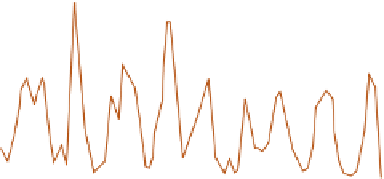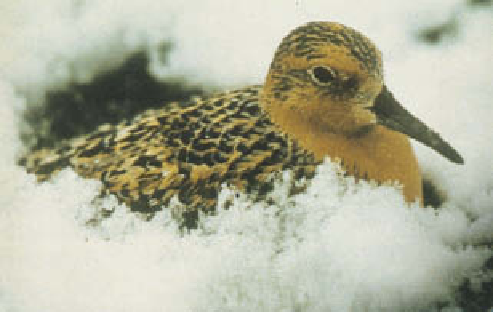Geoscience Reference
In-Depth Information
'growing season' presents grave risks to breeding success in
arctic wildlife. This knot is attempting to nest in 'spring'.
Photo: Fritz Müller
recognized the eleven-year cycle of the lynx and the
snowshoe hare (
Figure 24.21
).
Arguing that hunting and
trapping pressure would not vary much from year to year,
he noted the cyclical nature of the population harvests,
with the predator following the abundance of prey. The
four-year population cycle of the lemming is well known,
and it in turn influences the size of the population of
arctic foxes, snowy owls and gyrfalcons, whose numbers
fluctuate in sympathy. Population cycles have also been
noted in caribou and walrus, and are likely to be more
common than is realized, given that there are few long-
term data on most Arctic animals. An adverse impact,
either through a natural cause (climate, disease) or
because of human action (overhunting, pollution), entails
a high probability of extinction if the impact occurs at the
trough of the cycle. Thus muskoxen were eliminated from
Russia (though now reintroduced from Canada), and the
muskox population of Canada was on the verge of
extinction in 1917, when a total ban on hunting was
introduced (
Plate 24.21
).
Bowhead whales were also on
the verge of extinction before protection.
Plate 24.19
Avalanches periodically destroy vegetation and
starting to recolonize this avalanche chute in the Canadian
Rockies.
Photo: Ken Atkinson
160
Hare
Lynx
120
HUMAN ACTIVITY
80
Construction problems
40
Cold regions are places where engineering is complicated
by the natural freezing and thawing of the ground, which
significantly increase construction costs. Permafrost
covers about 50 per cent of the land surface in Canada
and Alaska, and 80 per cent of Russia and northern
Scandinavia (see
Chapter 15).
It greatly complicates
0
1845
1875
1905
1935
hare and lynx as indicated by furs traded by the Hudson's Bay
Company, 1845-1935.
Source: Adapted from Elton (1958)




































































